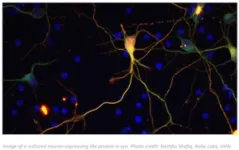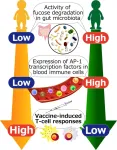(Press-News.org) TORONTO - In a study published in Nature Communications, a team led by Krembil Brain Institute Senior Scientists, Drs. Lorraine Kalia and Suneil Kalia, and University of Toronto (U of T) Professor, Dr. Philip M. Kim, identified a protein-protein interaction that contributes to Parkinson’s disease.
In the disease, a protein called α-synuclein (a-syn) accumulates in the brain and leads to cell death. Much research is currently focused on clearing a-syn with antibodies or using small molecules to prevent a-syn from aggregating. In this study, the researchers took an alternate approach by looking for protein-protein interactions that may be promoting the accumulation of a-syn in Parkinson’s disease.
Protein-protein interactions govern virtually all the inner workings of the cell, including breaking down disease-causing proteins. Inhibiting certain interactions has emerged as a promising approach to treat diseases such as stroke and cancer.
“Identifying a particular interaction that contributes to a disease and then finding ways to disrupt it, can be a painstaking and incredibly slow process,” explains Dr. Lorraine Kalia, who is also a staff neurologist at UHN and a scientist at U of T’s Tanz Centre for Research in Neurodegenerative Diseases, in the Temerty Faculty of Medicine.
“We all started out a bit skeptical that we would have something useful at the end, and so the fact that we do have something that warrants further work is much more than we anticipated.”
According to Dr. Kim, the team took the reverse approach to expedite the discovery of potential therapies. “We developed a platform to screen molecules called peptide motifs—short strings of amino acids that can disrupt protein-protein interactions—for their ability to protect cells from a-syn. Once we identified candidate peptides, we determined which protein-protein interactions they target.”
Through this approach, the team identified a peptide that reduced a-syn levels in cells by disrupting the interaction between a-syn and a protein subunit of the cellular machinery called ‘endosomal sorting complex required for transport III’ (ESCRT-III).
“ESCRT-III is a component of a pathway that cells use to break down proteins, called the endolysosomal pathway,” explains Dr. Lorraine Kalia. “We discovered that a-syn interacts with a protein within ESCRT-III—CHMP2B—to inhibit this pathway, thereby preventing its own destruction.”
“We were impressed that the platform worked,” she adds. “But I think what was more interesting is that, by doing this kind of screening, we were able to find an interaction that was really not previously characterized, and we also found a pathway that’s not yet been targeted for therapeutics.”
According to Dr. Suneil Kalia, once the group identified this interaction, they confirmed that they could use their peptide to disrupt it, preventing a-syn from evading the cell’s natural clearance pathways.
“We tested the peptide in multiple experimental models of Parkinson’s disease, and we consistently found that it restored endolysosomal function, promoted a-syn clearance and prevented cell death,” he said.
These findings indicate that the a-syn-CHMP2B interaction is a potential therapeutic target for the disease, as well as other conditions that involve a buildup of a-syn, such as dementia with Lewy bodies.
The next steps for this research are to clarify exactly how a-syn and CHMP2B interact to disrupt endolysosomal activity. Ongoing studies are also determining the best approach for delivering potential therapeutics to the brain.
“This research is still in its early stages—more work is definitely needed to translate this peptide into a viable therapeutic,” cautions Dr. Lorraine Kalia. “Nonetheless, our findings are very exciting because they suggest a new avenue for developing treatments for Parkinson’s disease and other neurodegenerative conditions.”
This study also highlights the value of multidisciplinary collaborations in health research.
“We simply could not have conducted this study in a silo,” says Dr. Suneil Kalia. “The endolysosomal pathway is underexplored, so it was not an obvious place to look for potential disease-related protein-protein interactions. Dr. Kim’s screening platform was critical for pointing us in the right direction.”
“It is extraordinary to see this platform—which we initially used to find potential therapeutics for cancer—yielding advances in brain research. The pathways that cells use to stay healthy are fundamentally very similar across tissues, so the insights that we gain about one organ system or disease could have important implications in other contexts,” says Dr. Kim.
“This is our first collaboration with Dr. Kim and it has been a productive one with a lot of synergy,” says Dr. Lorraine Kalia. “Seeking out technologies that are being used in other fields and applying them to our own field, we hope this will accelerate Parkinson’s research.”
She adds: “It’s really brand new science and brand new targets that haven’t been a focus for drug development for Parkinson’s. We hope this changes the landscape for treatment of this disease, which is so in need of new therapies.”
This work was supported by the Canadian Institutes of Health Research, the Michael J. Fox Foundation for Parkinson’s Research, Parkinson’s UK, the Canada Foundation for Innovation, the Ontario Research Fund, the Krembil Research Institute and the UHN Foundation. Dr. Lorraine Kalia is an Associate Professor in the Division of Neurology, Department of Medicine, and in the Department of Laboratory Medicine and Pathobiology, at U of T. Dr. Suneil Kalia is an Associate Professor in the Division of Neurosurgery, Department of Surgery, and the R.R. Tasker Chair in Stereotactic and Functional Neurosurgery at UHN. Dr. Philip Kim is a Professor and Principal Investigator in the Department of Molecular Genetics, Donnelly Centre for Cellular and Biomolecular Research, UofT.
The University of Toronto submitted a patent application covering the composition and use of the peptides and screening methods outlined in this study, with Drs. Satra Nim, Carles Corbi-Verge, Suneil Kalia, Lorraine Kalia and Philip Kim as inventors. Drs. Suneil Kalia, Lorraine Kalia and Philip Kim co-founded Synepark Therapeutics Inc. to commercialize aspects of this research.
About the Krembil Brain Institute
The Krembil Brain Institute at Toronto Western Hospital, part of University Health Network, is home to one of the world’s largest and most comprehensive teams of physicians and scientists uniquely working hand-in-hand to prevent and confront problems of the brain and spine. One in three Canadians will experience a brain-related condition such as Parkinson’s, Alzheimer’s or epilepsy in their lifetime. Through state-of-the-art patient care and advanced research, we are working relentlessly to find new treatments and cures. For more information: https://www.uhn.ca/krembil
About University Health Network
University Health Network consists of Toronto General and Toronto Western Hospitals, the Princess Margaret Cancer Centre, Toronto Rehabilitation Institute, and The Michener Institute of Education at UHN. The scope of research and complexity of cases at University Health Network has made it a national and international source for discovery, education and patient care. It has the largest hospital-based research program in Canada, with major research in cardiology, transplantation, neurosciences, oncology, surgical innovation, infectious diseases, genomic medicine and rehabilitation medicine. University Health Network is a research hospital affiliated with the University of Toronto. For more information: https://www.uhn.ca/
About the Temerty Faculty of Medicine at the University of Toronto:
The Temerty Faculty of Medicine at the University of Toronto is at the centre one of North America’s largest biomedical research, education and clinical care networks. With nine fully affiliated research-intensive hospitals — and dozens of community and clinical care sites — Temerty Medicine offers unparalleled opportunities in Canada’s most dynamic city for our more than 9,000 faculty and staff and 7,000 learners at all levels. For more information: https://temertymedicine.utoronto.ca/
MEDIA CONTACTS:
Heather Sherman
Communications Manager, Krembil Brain Institute/UHN
Heather.sherman@uhn.ca
Jim Oldfield
Senior Communications Officer, Temerty Faculty of Medicine/U of T
jim.oldfield@utoronto.ca
END
Researchers identify a potential new therapeutic target in Parkinson’s disease
Researchers found a peptide that’s never been described before, an interaction that’s never been appreciated before, and a potential new avenue for therapeutics in Parkinson’s disease
2023-04-20
ELSE PRESS RELEASES FROM THIS DATE:
Dr. Natalya Chernichenko named site chief of otolaryngology at NewYork-Presbyterian Brooklyn Methodist Hospital
2023-04-20
Dr. Natalya Chernichenko, a leading otolaryngologist who specializes in tumors of the head and neck, has been named site chief of otolaryngology at NewYork-Presbyterian Brooklyn Methodist Hospital, effective May 1. Dr. Chernichenko was also recruited to Weill Cornell Medicine as an assistant professor of clinical otolaryngology and vice chair in the Department of Otolaryngology—Head and Neck Surgery.
In her new role, Dr. Chernichenko will lead a skilled team of specialists and surgeons providing comprehensive otolaryngology care, also known as ear, nose and throat, or ENT care, and further develop the hospital’s head and neck surgical oncology ...
FAU gets $6 million to increase mental health counselors in Florida schools
2023-04-20
Youth mental and emotional health is a matter of high priority in Florida. A 2019 Florida Department of Health survey showed that 12.7 percent of Florida high schoolers (grades 9 to 12) had carried a weapon; 21.2 percent were involved in a physical altercation; 24.2 percent reported having been teased about their size, weight or physical appearance; and 11.3 percent and 14.9 percent were bullied electronically or on school property, respectively.
In this same survey, 15.6 percent of Florida high school students reported they had seriously considered attempting suicide, and 33.7 percent acknowledged feeling sad or hopeless for two or more weeks in a row. Alarmingly, the 2019 survey ...
University of Cincinnati research examines the impact of maternal stress during pregnancy on child’s health
2023-04-20
New research out of the University of Cincinnati examines the impact that maternal stress during pregnancy has on the neurodevelopment of babies.
The study was published in the journal Molecular Psychiatry.
Prenatal maternal stress life events are associated with adverse neurodevelopmental outcomes in offspring. Biological mechanisms underlying these associations are largely unknown, but a chemical reaction in the body in which a small molecule known as a methyl group gets added to DNA, called DNA methylation, likely plays a role, according to researchers. These findings could provide new insights into how the fetal environment potentially influences ...
TIBI Director and CEO Ali Khademhosseini receives Technology Innovation and Development award from the Society for Biomaterials
2023-04-20
(LOS ANGELES) – April 20, 2023 - Dr. Ali Khademhosseini has been awarded the 2023 Technology Innovation and Development Award from the Society of Biomaterials (SFB). The award honors those whose research, scientific innovations, and leadership are used to develop novel products or technologies to benefit patients.
Dr. Khademhosseini is the founding Director and CEO of the Terasaki Institute for Biomedical Innovation (TIBI), which incorporates a variety of interdisciplinary research platforms and uses patient-derived cells for micro- and ...
Novel antibiotic-delivery system to target aggressive gum infections in adolescents
2023-04-20
Aggressive periodontitis is a severe type of gum infection that causes the destruction of ligament and bone and can lead to tooth loss in otherwise healthy individuals. Traditional treatment typically involves deep cleaning and antibiotics.
Lehigh University researcher Angela Brown and her team were recently awarded a grant from the National Institutes of Health (NIH) to pursue a novel treatment alternative.
Brown, an associate professor of chemical and biomolecular engineering in Lehigh’s P.C. Rossin College of Engineering and Applied Science, received an Exploratory/Development Research ...
Is Deep Learning a necessary ingredient for Artificial Intelligence?
2023-04-20
The earliest artificial neural network, the Perceptron, was introduced approximately 65 years ago and consisted of just one layer. However, to address solutions for more complex classification tasks, more advanced neural network architectures consisting of numerous feedforward (consecutive) layers were later introduced. This is the essential component of the current implementation of deep learning algorithms. It improves the performance of analytical and physical tasks without human intervention, and lies behind everyday automation products such as the emerging technologies for self-driving cars and autonomous chat bots.
The key question driving new research published today in Scientific ...
Study gives insight into cause of severe inflammatory bowel disease
2023-04-20
Cedars-Sinai investigators have identified a genetic variant that increases people’s risk of developing perianal Crohn’s disease, the most debilitating manifestation of Crohn’s disease.
The variant generates changes to DNA that lead to a loss of protein function, which in turn, alters how the body recognizes and handles bacteria, making it less effective at fighting infections.
The discovery is published in the peer-reviewed journal GUT.
“Fistulizing perianal Crohn’s disease ...
Gut bacteria could be behind weaker immune responses to COVID-19 vaccine
2023-04-20
Gut bacteria that break down a sugar called fucose could be dampening our immune response to the COVID-19 mRNA vaccine, according to a study led by researchers from the Okinawa Institute of Science and Technology (OIST).
The scientists report that increased fucose digestion by bacteria in the gut before vaccination was associated with lower numbers of T-cells activated by vaccination. T-cells are an important type of blood immune cell that are activated by a specific strain of bacteria or virus, and then multiply to fight the infection.
The findings, published ...
Swedish quantum computer applied to chemistry for the first time
2023-04-20
There are high expectations that quantum computers may deliver revolutionary new possibilities for simulating chemical processes. This could have a major impact on everything from the development of new pharmaceuticals to new materials. Researchers at Chalmers University have now, for the first time in Sweden, used a quantum computer to undertake calculations within a real-life case in chemistry.
“Quantum computers could in theory be used to handle cases where electrons and atomic nuclei move in more complicated ways. If we can learn to utilise their full potential, we should be able to advance the boundaries of what is possible to calculate and understand,” says Martin Rahm, ...
Polar ice sheet melting records have toppled during the past decade
2023-04-20
The seven worst years for polar ice sheets melting and losing ice have occurred during the past decade, according to new research, with 2019 being the worst year on record.
The melting ice sheets now account for a quarter of all sea level rise – a fivefold increase since the 1990’s – according to IMBIE, an international team of researchers who have combined 50 satellite surveys of Antarctica and Greenland taken between 1992 and 2020.
Their findings are published today in the journal Earth System Science Data.
Global heating is melting ...
LAST 30 PRESS RELEASES:
Injectable breast ‘implant’ offers alternative to traditional surgeries
Neuroscientists devise formulas to measure multilingualism
New prostate cancer trial seeks to reduce toxicity without sacrificing efficacy
Geometry shapes life
A CRISPR screen reveals many previously unrecognized genes required for brain development and a new neurodevelopmental disorder
Hot flush treatment has anti-breast cancer activity, study finds
Securing AI systems against growing cybersecurity threats
Longest observation of an active solar region
Why nail-biting, procrastination and other self-sabotaging behaviors are rooted in survival instincts
Regional variations in mechanical properties of porcine leptomeninges
Artificial empathy in therapy and healthcare: advancements in interpersonal interaction technologies
Why some brains switch gears more efficiently than others
UVA’s Jundong Li wins ICDM’S 2025 Tao Li Award for data mining, machine learning
UVA’s low-power, high-performance computer power player Mircea Stan earns National Academy of Inventors fellowship
Not playing by the rules: USU researcher explores filamentous algae dynamics in rivers
Do our body clocks influence our risk of dementia?
Anthropologists offer new evidence of bipedalism in long-debated fossil discovery
Safer receipt paper from wood
Dosage-sensitive genes suggest no whole-genome duplications in ancestral angiosperm
First ancient human herpesvirus genomes document their deep history with humans
Why Some Bacteria Survive Antibiotics and How to Stop Them - New study reveals that bacteria can survive antibiotic treatment through two fundamentally different “shutdown modes”
UCLA study links scar healing to dangerous placenta condition
CHANGE-seq-BE finds off-target changes in the genome from base editors
The Journal of Nuclear Medicine Ahead-of-Print Tip Sheet: January 2, 2026
Delayed or absent first dose of measles, mumps, and rubella vaccination
Trends in US preterm birth rates by household income and race and ethnicity
Study identifies potential biomarker linked to progression and brain inflammation in multiple sclerosis
Many mothers in Norway do not show up for postnatal check-ups
Researchers want to find out why quick clay is so unstable
Superradiant spins show teamwork at the quantum scale
[Press-News.org] Researchers identify a potential new therapeutic target in Parkinson’s diseaseResearchers found a peptide that’s never been described before, an interaction that’s never been appreciated before, and a potential new avenue for therapeutics in Parkinson’s disease









